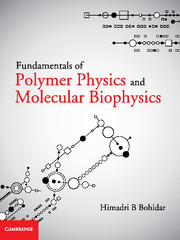Book contents
- Frontmatter
- Contents
- List of Figures
- List of Tables
- Preface
- 1 Essential Thermodynamic and Statistical Concepts
- 2 Polymer Structure and Nomenclature
- 3 Polymer Solutions
- 4 Phase Stability and Phase Transitions
- 5 Static Properties of Single Chains
- 6 Diffusion
- 7 Viscosity of Polymer Solutions
- 8 Sedimentation
- 9 Concentration Regimes and Scaling
- 10 Internal Dynamics
- 11 Dynamics in Polymer Gels
- 12 Molecular Biophysics
- 13 Structure of Biopolymers
- 14 Physics of Proteins
- 15 Physics of Nucleic Acids
- 16 Special Topics
- Index
- References
12 - Molecular Biophysics
Published online by Cambridge University Press: 05 August 2014
- Frontmatter
- Contents
- List of Figures
- List of Tables
- Preface
- 1 Essential Thermodynamic and Statistical Concepts
- 2 Polymer Structure and Nomenclature
- 3 Polymer Solutions
- 4 Phase Stability and Phase Transitions
- 5 Static Properties of Single Chains
- 6 Diffusion
- 7 Viscosity of Polymer Solutions
- 8 Sedimentation
- 9 Concentration Regimes and Scaling
- 10 Internal Dynamics
- 11 Dynamics in Polymer Gels
- 12 Molecular Biophysics
- 13 Structure of Biopolymers
- 14 Physics of Proteins
- 15 Physics of Nucleic Acids
- 16 Special Topics
- Index
- References
Summary
Biophysics is not a single entity. It is a congregate of a plethora of disciplines such as molecular biology, physics, chemistry, biochemistry, bioinformatics, nanotechnology and even mathematics, to name a few. It answers a lot of questions quite similar to the ones researched in molecular biology but uses very unconventional methods to do so. To put it simply, it studies the interaction of various systems of a cell within the cell itself and outside it and can cover an astonishingly wide range of topics. More specifically, biophysics is the study of life phenomenon.
The living organism and the biosphere are not isolated; they exchange matter and energy continuously. From the thermodynamic perspective, “A living organism feeds on negative entropy”. Several alternative definitions exist. For example, the postulate of life states that “Life itself should be looked upon as a basic postulate of biology that does not lend itself to further analysis”. According to Bohr's uncertainty principle, “Physico-chemical properties of living organisms and the life phenomenon cannot be studied simultaneously”. This implies that cognition of one excludes the other. According to Schrödinger, “An organism is an aperiodic crystal”. This is a very well-defined conceptualization of any organism. An organism is a complex many-body system of numerous biomolecules interacting through innumerable physico-chemical reactions in an orderly, coordinated and regulated manner. In physical science, a crystal exhibits spatial order which allows a comprehensive description of this material through statistical means. However, no such order is observed in living organisms. Nonetheless, millions of biochemical reactions are carried out with excellent accuracy and reproducibility inside the numerous cells constituting the organism.
- Type
- Chapter
- Information
- Fundamentals of Polymer Physics and Molecular Biophysics , pp. 192 - 205Publisher: Cambridge University PressPrint publication year: 2015



